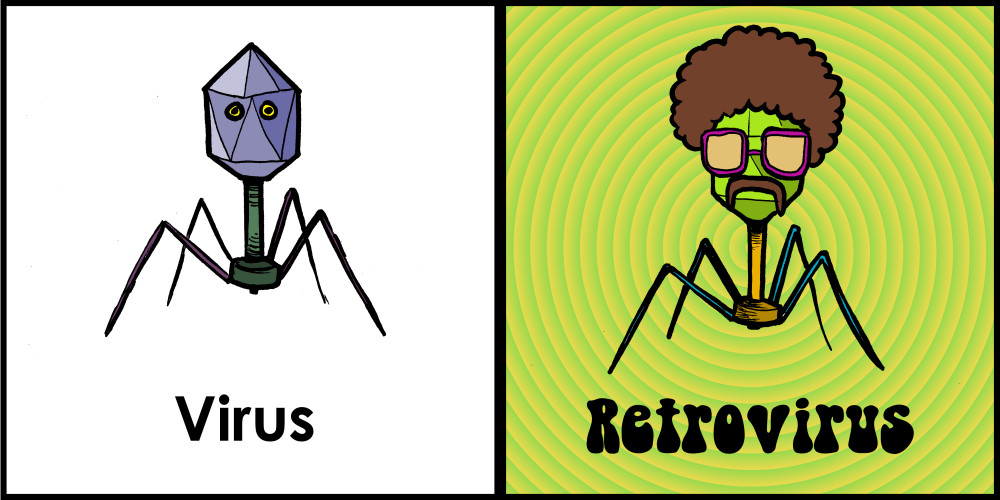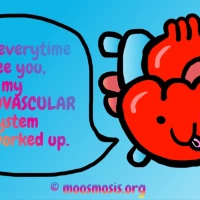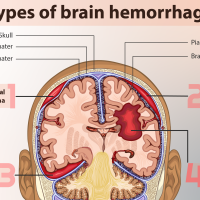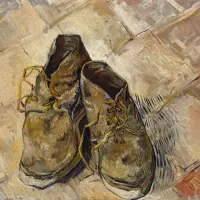Introduction: What is A Retrovirus?
Retroviruses are a class of viruses that not only infect host cells but also integrate their genetic material into the host genome, establishing a permanent infection that cannot be cured. The most common retrovirus is the human immunodeficiency virus or HIV, which targets and destroys helper T-cells.
Retroviruses can target many different species in addition to humans. For example, the Rous Sarcoma virus is a retrovirus that infects chickens.

Health Risks of Retroviral Infections
During HIV infection, the continuous destruction of helper T-cells weakens the immune system, leading to acquired immunodeficiency syndrome or AIDS. Once the immune system is sufficiently incapacitated, opportunistic infections from other viruses, bacteria, or fungi can further strain and damage the body. Interestingly, these opportunistic or secondary infections are often more dangerous than the initial infection by HIV.
In addition to the viral infection and opportunistic infections, some retroviruses directly cause other health issues as well. For example, oncogenic retroviruses, a subclass of retroviruses, are known to cause cancer. This phenomenon was first discovered in the Rous Sarcoma virus.
Keep in mind that retroviruses establish permanent infections that can never be cured. However, various antiretroviral treatments are available. These treatments need to be continued lifelong to combat viral replication inside the body.
The Retroviral Life Cycle

It is important to understand the mechanism by which a retrovirus can enter a host cell and replicate. A thorough understanding of each step allows researchers to design treatment strategies, known as antiretroviral therapies, to treat retroviral infections.
- Binding – Before entering the cell, the retrovirus particle must bind to cellular receptor. The interaction between the virus’s outer surface or envelope and the receptor on the host cell allows cell entry to occur.
- Cell Entry – Once the viral envelope binds the host cell surface receptor, the plasma membranes of the virus and host cell fuse together, allowing the virus to enter the cell. Once inside, the virus’s genetic material (RNA) is released into the cytoplasm.
- Reverse Transcription – The retrovirus aims to integrate its genetic material (RNA) into the host genome, which is made up of DNA. In order to do this, the virus converts its single-stranded RNA genome into double-stranded DNA. This is done by a viral protein known as reverse transcriptase.
- Integration – The newly created viral DNA can be carried into the nucleus and integrated into the host genome. This is done by a viral protein known as integrase.
- Viral Protein Assembly – Once viral genetic material is inserted into the host genome, host proteins inadvertently create viral proteins. In this way, the retrovirus hijacks the host machinery to create more viruses.
- Replication – These new viral proteins include proteins like reverse transcriptase and integrate, along with other structural proteins needed to create new viruses. All of these proteins come together to assemble a new virus, called a virion. These new viruses are expelled from the host cell and go off in search of other cells to infect.
Antiretroviral Therapy for HIV

Antiretroviral drugs for HIV function by blocking one the six steps of the life cycle, discussed above. For example, fusion inhibitors such as Enfuvirtide block the cell from ever entering the cell by preventing membrane fusion. Other antiretroviral drugs such as Abacavir target the third step, preventing reverse transcription from working properly. As a result, the virus is unable to convert its RNA genome into a DNA copy, halting viral replication and subsequent infection.
Antiretroviral drugs are often combined and given to patients as a cocktail. In this way, each individual drug can target a different stage of the retroviral life cycle. Together, these drugs are more effective than any one drug alone. Patients undergoing antiretroviral therapy have a significantly reduced risk of opportunistic infections and can lead more healthy lives.
Works Cited
- Travella, Vincent. “What Is a Retrovirus” Healthline. 1 Mar. 2019, https://www.healthline.com/health/what-is-a-retrovirus
- “What are Opportunistic Infection” HIV.gov, https://www.hiv.gov/hiv-basics/staying-in-hiv-care/other-related-health-issues/opportunistic-infections
- Bishop, Kate. The Francis Crick Institute, https://www.crick.ac.uk/research/labs/kate-bishop/areas-of-interest
- “Viral Replication and Behavior” National Cancer Institute, https://home.ncifcrf.gov/hivdrp/RCAS/replication.html
- “How Do You Treat HIV?” WedMD, https://www.webmd.com/hiv-aids/understanding-aids-hiv-treatment#1
Check out these popular articles 🙂
Circulatory System: Blood Flow Pathway Through the Heart
Ectoderm vs Endoderm vs Mesoderm
Circulatory System: Heart Structures and Functions
Ductus Arteriosus Vs Ductus Venosus Vs Foramen Ovale: Fetal Heart Circulation
Cardiac Arrhythmias: Definition, Types, Symptoms, and Prevention
Upper Vs Lower Respiratory System: Upper vs Lower Respiratory Tract Infections
Seven General Functions of the Respiratory System
Digestive System Anatomy: Diagram, Organs, Structures, and Functions
Kidney Embryology & Development: Easy Lesson
Autocrine vs Paracrine vs Endocrine: What are the Differences?
Their Eyes Were Watching God: Mule Symbol
Shoulder Abduction Muscles: Medical Anatomy and USMLE
Cell Membrane Dynamics: Flippase vs Floppase vs Scramblase
Cell Membrane Fluidity: Factors That Influence and Increase the Cell Membrane Fluidity
Psychology 101: Crowd Psychology and The Theory of Gustave Le Bon
Introduction to Evolution: Charles Darwin and Alfred Russel Wallace
An Overview of Shorthand: History and Types of Shorthand
Calculus: Two Important Theorems – The Squeeze Theorem and Intermediate Value Theorem
Copyright © 2022 Moosmosis Organization: All Rights Reserved
All rights reserved. This essay first published on moosmosis.org or any portion thereof may not be reproduced or used in any manner whatsoever
without the express written permission of the publisher at moosmosis.org.

Please Like and Subscribe to our Email List at moosmosis.org, Facebook, Twitter, Youtube to support our open-access youth education initiatives! 🙂
Categories: anatomy, Biology, cell biology, education, health, immunology, medicine, Social Studies














Interesting!
LikeLiked by 2 people
Retroviruses with the hippies hairdo! 🙂
LikeLiked by 1 person
Haha 😀
LikeLiked by 1 person
Great info on the HIV virus and the life cycle
LikeLiked by 2 people
Coronavirus vs retrovirus
COVID-19 vs HIV
The ultimate showdown!
LikeLiked by 2 people